


The enigmatic evolution of ecosystems as well as their phenomenology during development has for long been a puzzle to ecological researchers and has led to the current wish to improve our understanding of these our study objects.

Some suggestions for essential future research agendas of issues that needs resolution are given. Examples of applications and results achieved up to now are given, and the importance to management laid out. This includes a brief outline of the history and the derivation of the thermodynamic functions used today. This paper aims to describe the state-of-the-art in implementation of thermodynamics into ecology. In brief, ecological succession is followed by an increase of exergy. Results show that natural and culturally induced changes in the ecosystems, are accompanied by a variations in exergy. Most of the supportive evidence comes from aquatic ecosystems. The major problem in the transfer to ecology is that thermodynamic properties can only be calculated and not measured. The fittest ecosystem, being the one able to use and store fluxes of energy and materials in the most efficient manner. The implementation of exergy in ecology has often been explained as a translation of the Darwinian principle of “survival of the fittest” into thermodynamics. The proposals take two main directions, one concerned with the exergy stored in the ecosystem, the other with the exergy degraded and entropy formation. Exergy has recently been proposed, from several directions, as a useful indicator of the state, structure and function of the ecosystem. Both have been applied in ecology since the 1950s and lately the concepts of exergy and entropy have been introduced. There seems little reason to doubt that far from equilibrium systems, such as organisms or ecosystems, also have to obey fundamental physical principles such as mass conservation, first and second law of thermodynamics. Combining these views from the far from equilibrium thermodynamics to traditional classical thermodynamics, and ecology is obviously not going to happen without problems. The entrance point of such an understanding of ecosystems was delivered more than 50 years ago through Schrödinger’s and Prigogine’s interpretations of living systems as “negentropy feeders” and “dissipative structures”, respectively. The last two decades have offered proposals for interpretation of ecosystems within a framework of thermodynamics. Ecosystems show a high degree of complexity, based upon a high number of compartments, interactions and regulations. This is not an easy task, as modern ecosystem theory exemplifies. To answer this we will need to give a scientific definition to concepts like sustainability, integrity, resilience and ecosystem health.
#Entropy biology how to#
How to predict the evolution of ecosystems is one of the numerous questions asked of ecologists by managers and politicians.


 0 kommentar(er)
0 kommentar(er)
